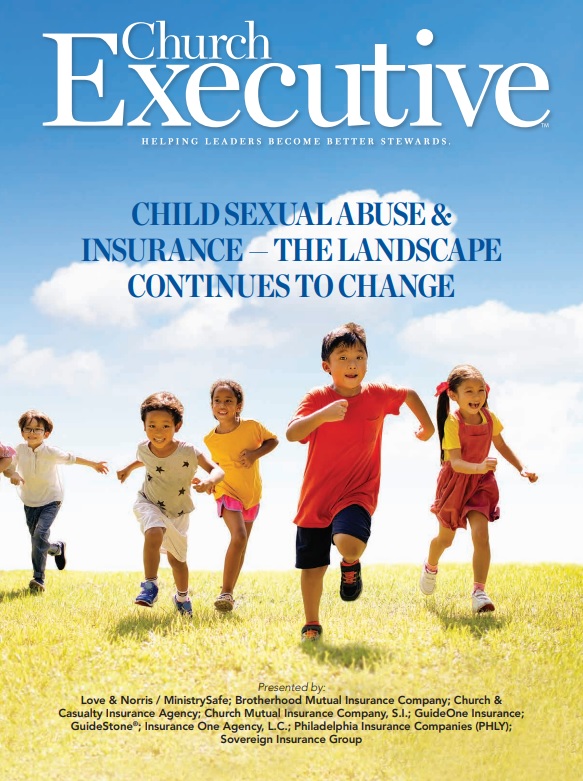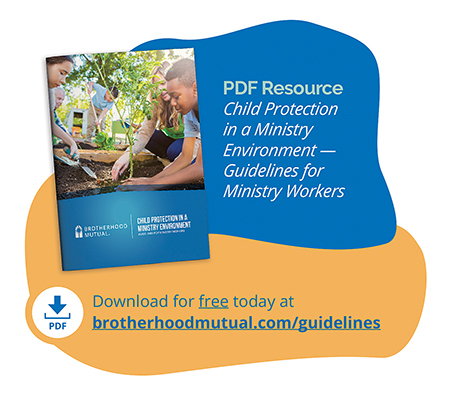

Associate Corporate Counsel
Brotherhood Mutual Insurance Company
Church is considered a safe place for healing and to grow in grace. It’s especially disheartening and scary when we see headlines that a predator has made their way into a church with the intent of hurting a child or vulnerable adult. We are likely to see more and more cases coming to light as victims feel support to come forward because of high-profile cases covered by the media and through movements such as #MeToo.
Research shows that predators use grooming techniques not only on the children they target, but their families, caretakers and the staff. Because many children are not able to come forward until adulthood, states have responded by expanding their statutes of limitations. Litigation almost always includes the organization that the predator used to gain access to children either as an employee, volunteer, teacher, or coach, for example.
Many ministries are looking to add insurance coverage to protect themselves for the future. At the same time, insurance carriers have lowered their risk appetite for offering sexual abuse and misconduct coverage. Additionally, many carriers have begun to exercise more caution before offering higher coverage limits.
If your ministry is seeking higher insurance coverage limits as part of its overall risk management plan, you might face greater scrutiny during the underwriting process. You can take steps that will not only help satisfy insurance underwriting requirements, but also protect the children, youth and vulnerable adults in your care.
Free Resource
Brotherhood Mutual’s® comprehensive child protection guidebook, Child Protection in a Ministry Environment — Guidelines for Ministry Workers, is available for free at www.brotherhoodmutual.com/guidelines. The guidebook addresses the importance of a written policy and its components. It also includes a sample policy, sample forms, and a checklist. Feel free to refer to this guidebook as your ministry develops or works to update its written child protection policies.
The importance of a written child protection policy

When seeking sexual abuse and misconduct coverage, it will help the underwriting process to share your ministry’s written abuse prevention policies and procedures. These policies should apply to all activities and events involving children, youth or vulnerable adults.
Consider taking an inventory of all your activities to help make sure that your ministry’s policies address all potential exposures. Children’s programming and youth ministry activities might quickly come to mind, but think about policies addressing youth sports, vacation Bible school, special needs ministry, or other less frequent activities involving minors.
Your ministry could improve its ability to obtain the necessary sexual abuse or misconduct coverage if it can show an underwriter its written procedures for screening all employees, regardless of position, and all volunteers who will work or interact with minors or vulnerable adults. Screening tools such as a written application form, reference checks, a criminal background check, and a personal interview are generally seen as necessary steps to help reduce the risk of hiring an employee or appointing a volunteer who poses a threat to others.
Don’t forget about supervision and training
Don’t assume that screening procedures alone will always prevent a predator from serving with minors or vulnerable adults. Written supervision procedures are a critical component of any child protection policy. Ideally, ministries should have procedures in place to avoid, or at least limit, opportunities for one-on-one interaction between adult employees or volunteers and minors. A “Two-Adult Rule” or “Rule of Three” could help your ministry meet this standard.
Know about mandatory reporting
An underwriter might want to see your ministry’s written procedures for reporting child abuse and neglect. Every state has its own mandatory reporting requirements, and an observation from your employees and volunteers during your activities might trigger these requirements. Written procedures help satisfy state requirements and direct staff if they suspect a child might be the victim of abuse or neglect.




I like how you mentioned that it will help the process to share your written abuse prevention procedures when seeking sexual abuse and misconduct coverage. A friend of mine mentioned to me last night about misconduct liability management and asked if I have any idea how the insurance works. Thanks to this informative article and I’ll be sure to tell him that it will be much better if he consults a trusted risk management company as they can answer all his inquiries.